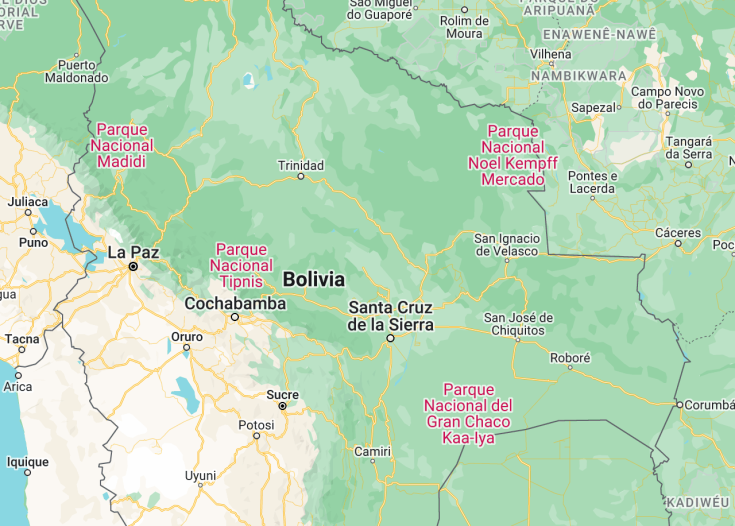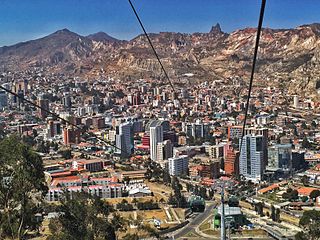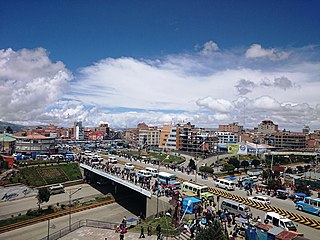Nestled in the heart of South America, Bolivia boasts an unparalleled blend of indigenous cultures, sweeping landscapes, and historical relics. Its diverse geography, ranging from the ethereal Uyuni Salt Flats to the verdant Amazonian jungles, contrasts beautifully with rich colonial architecture in cities like Sucre. The nation’s vibrant markets and festivals showcase its deep-rooted traditions, while the remnants of ancient civilizations, such as Tiwanaku, whisper tales from a bygone era. Bolivia is a treasure trove for intrepid travelers seeking both adventure and cultural immersion.
Plan your journey around Bolivia’s festivals; the Oruro Carnival is a cultural spectacle not to be missed.
For an authentic experience, spend a night in a traditional “Eco-Lodge” while exploring the Amazon.
Bolivia: Land of the Andes
| Capital | La Paz |
| Time in Bolivia | GMT -4 |
| Language spoken | Spanish |
| Population | 11,673,021 (source: World Bank) |
| Religion | Roman Catholic (76%) Evangelical Protestant (8%) Other (8%) |
| Currency | Boliviano (Bs., BOB) |
| Airports | El Alto International Airport Viru Viru International Airport Capitan Oriel Lea Plaza Airport |
Located in the heart of South America, Bolivia is a country of contrasts, presenting a blend of rich cultures, diverse landscapes, and ancient civilizations. From its Andean peaks to its vast salt flats and dense Amazonian rainforests, Bolivia boasts an astounding natural beauty. Historically, it was the epicenter of major pre-Columbian empires like the Tiwanaku and the Inca. The Spanish conquest in the 16th century brought about significant cultural shifts, turning Bolivia into a vital source of silver. In modern times, Bolivia is both a guardian of indigenous traditions and a country experiencing dynamic changes, ever-proud of its multiethnic identity and deep-rooted history.
Where is Bolivia located?
Bolivia is a landlocked country situated in western-central South America, bordered by Brazil to the north and east, Paraguay and Argentina to the south, and Chile and Peru to the west. Its diverse geography encompasses the Amazon Basin, the Andean mountain range, and the expansive high-altitude plateau known as the Altiplano.
What is Bolivia famous for?
Bolivia is renowned for its stunning natural landscapes, including the otherworldly salt flats of Uyuni, the breathtaking Lake Titicaca, and the awe-inspiring peaks of the Cordillera Real. It is also home to an array of vibrant indigenous cultures, each with its own distinct traditions and heritage. Visitors to Bolivia can explore ancient Inca ruins, traverse colonial cities, and embark on thrilling outdoor adventures such as hiking, mountain biking, and wildlife spotting.
History
Ancient Civilizations (1500 BC – 1400 AD)
Long before the Spanish arrived, the region now known as Bolivia was inhabited by ancient cultures. The Tiahuanaco civilization, for instance, thrived near Lake Titicaca from around 1500 BC to 1200 AD. Their remarkable stone structures and cultural artifacts offer clues to a sophisticated society with advanced understanding of astronomy and agriculture.
The Inca Empire (15th Century)
By the 15th century, the powerful Inca Empire extended its reach into the Bolivian highlands. Under their reign, an elaborate road system was constructed, connecting vast territories of the empire. Though the Incas held power for a relatively short period, their influence on culture, language, and architecture remains evident today.
Spanish Colonization (1532 – 1809)
Spanish explorers, led by Francisco Pizarro, began their conquest of the region in the 1530s, drawn by the allure of silver deposits. The indigenous population was subjected to forced labor, particularly in the notorious Potosí silver mines. The Spanish imposed their language, religion, and customs, leading to a fusion of indigenous and European cultures that shapes Bolivia to this day.
Quest for Independence (1809 – 1825)
The early 19th century saw rising discontent against Spanish rule. Bolivians, inspired by revolutions in North America and France, initiated their rebellion in 1809. After a prolonged struggle, Simon Bolivar, the liberator of much of South America, and his general Antonio José de Sucre, played crucial roles in achieving Bolivia’s independence in 1825. The newly independent nation was named in honor of Bolivar.
The 20th Century and the Tin Barons (1900 – 1980)
Throughout the 20th century, Bolivia grappled with numerous challenges including territorial disputes, such as the Chaco War with Paraguay, and internal power struggles. The tin industry boomed, leading to the rise of influential tin magnates. However, the country also saw frequent coups, with the military often intervening in politics.
Modern Bolivia (1980-Present)
From the 1980s onward, Bolivia underwent significant political and economic transformations. Democracy was restored in 1982 after decades of military rule. The country also embraced neoliberal economic policies, focusing on privatization and free-market reforms. In 2006, Evo Morales was elected as the first indigenous president, reflecting a broader shift in Latin American politics. Under his leadership, Bolivia nationalized key industries and implemented social programs. While Morales was a polarizing figure, his tenure marked a significant shift in the political landscape of Bolivia.
Visit Bolivia
What to see and do in Bolivia
Bolivia offers a rich cultural and natural heritage. Here are some must-see attractions:
- The Uyuni Salt Flats: Explore the world’s largest salt flat, a stunning landscape of salt plains stretching as far as the eye can see.
- Tiwanaku: Visit the ancient ruins of Tiwanaku, an important pre-Columbian archaeological site.
- La Paz: Discover the vibrant capital city, known for its colorful markets, colonial architecture, and stunning views of the surrounding mountains.
- Lake Titicaca: Explore the highest navigable lake in the world and visit its fascinating islands, including the famous floating Uros islands.
- The Yungas Road: Embark on a thrilling journey along the “Death Road,” a notorious mountain road known for its dangerous curves and stunning views.
Events in Bolivia
Bolivia hosts various events throughout the year, showcasing its cultural traditions and vibrant celebrations.
One of the most famous events is the Carnival of Oruro, held in the city of Oruro. This colorful and lively festival features traditional dances, music, and vibrant costumes. It takes place in February and attracts both locals and tourists from around the world.
Another significant event is the Inti Raymi, or Festival of the Sun, which is celebrated in June. It is a traditional Inca festival that pays homage to the sun deity and includes rituals, dances, and processions.
Other notable events include the Bolivian Independence Day celebrations on August 6th and the Folklore Festival of Potosi in November.
Best time to visit Bolivia
The best time to visit Bolivia depends on the specific region and activities you plan to engage in. Generally, the dry season from May to October is considered the best time to visit, as it offers clear skies and pleasant temperatures.
In the highland areas, such as La Paz and the Uyuni Salt Flats, it can get very cold, especially at night, so it is advisable to bring warm clothing. The wet season from November to March can bring heavy rainfall and make certain areas inaccessible.
If you are interested in participating in traditional festivals and cultural events, it is recommended to plan your visit during the festival season, which varies depending on the specific event.
Is Bolivia worth visiting?
Bolivia is definitely worth visiting for those seeking unique cultural experiences and breathtaking natural landscapes. From the otherworldly Uyuni Salt Flats to the ancient ruins of Tiwanaku, Bolivia offers a fascinating glimpse into rich indigenous traditions and history.
However, it is important to note that Bolivia is still a developing country and may present challenges in terms of infrastructure and services. Travelers should be prepared for potential altitude sickness in highland areas and should take necessary precautions.
Despite these challenges, Bolivia’s natural beauty and cultural richness make it an unforgettable destination for adventurous travelers. Whether exploring the vibrant markets of La Paz or hiking through the stunning Andean landscapes, Bolivia offers a truly unique and off-the-beaten-path experience.
Common questions
What are the must-see attractions in Bolivia?
- Uyuni Salt Flats – Discover the mesmerizing salt flats, with its vast expanse of white salt spread out like a mirror reflection.
- Tiwanaku – Explore the ancient ruins of Tiwanaku, a UNESCO World Heritage site and an important archaeological site in Bolivia.
- La Paz – Immerse yourself in the bustling city life of La Paz, the highest administrative capital in the world.
- Potosi – Visit the historic city of Potosi, known for its rich colonial architecture and the Cerro Rico silver mines.
- Madidi National Park – Embark on a wildlife adventure in Madidi National Park, home to diverse species of plants and animals.
- Lake Titicaca – Experience the beauty of Lake Titicaca, the highest navigable lake in the world, with its stunning scenery and unique culture.
- Yungas Road – Brave the thrilling Yungas Road, also known as “Death Road,” for an adrenaline-pumping biking experience.
- Salar de Uyuni – Marvel at the surreal landscapes of Salar de Uyuni, the largest salt flat in the world.
- Avenida de las Pocas Pulgas – Stroll along the picturesque Avenida de las Pocas Pulgas and admire its beautiful architecture.
- Torotoro National Park – Discover the wonders of Torotoro National Park, famous for its dinosaur footprints and natural formations.
- Valle de la Luna – Explore the otherworldly Valle de la Luna (Valley of the Moon) with its unique lunar-like landscapes.
- Rurrenabaque – Venture into Rurrenabaque, the gateway to the Bolivian Amazon, and embark on a jungle adventure.
What is the best time to visit Bolivia?
What is the currency used in Bolivia?
What are the visa requirements for visiting Bolivia?
What are the transportation options within Bolivia?
- Buses: Buses are the primary mode of transportation in Bolivia, connecting different cities and towns. There are both local and long-distance buses available, ranging from basic to more comfortable options.
- Taxis: Taxis are widely available in major cities and towns. It’s recommended to negotiate the fare or use a metered taxi.
- Trains: Bolivia has a limited train network, but it’s a unique way to travel between certain destinations, such as from Oruro to Uyuni.
- Domestic Flights: For longer distances, domestic flights are available, connecting major cities like La Paz, Santa Cruz, and Cochabamba.
- Boats: In certain areas, such as Lake Titicaca or the Amazon region, boats and ferries provide transportation for scenic journeys.
What are the popular dishes to try in Bolivia?
- Salteñas: These are delicious, savory pastries filled with beef, chicken, or vegetables.
- Silpancho: Silpancho is a traditional Bolivian dish consisting of breaded and fried beef cutlets served with rice, potatoes, and fried eggs on top.
- Salteña: A stew-like dish made with white corn, meat (usually chicken or beef), and various vegetables and spices.
- Pique a lo Macho: A hearty dish made with beef, sausage, onions, peppers, tomatoes, and potatoes, all served on a bed of fries.
- Trucha Frita: Trucha Frita is a popular dish featuring fried trout, often served with rice, salad, and fried potatoes.
- Api con Pastel: A warm, thick corn drink served with a sweet pastry called Pastel.
- Choripan: A simple but delicious street food consisting of a grilled chorizo sausage served on a crusty bread roll.
- Sopa de Mani: A tasty peanut soup containing a variety of meats, vegetables, and spices.
What are the most popular festivals in Bolivia?
- Carnaval: Carnaval is a lively and energetic celebration that takes place in various cities across Bolivia, featuring vibrant parades, music, dancing, and water fights.
- La Diablada: La Diablada is a traditional dance festival celebrated primarily in Oruro, showcasing elaborate costumes and masks.
- Yapacaní Carnival: The Yapacaní Carnival is celebrated in the town of Yapacaní and is known for its lively street parades, music, and dancing.
- Gran Poder Festival: The Gran Poder Festival is held in La Paz and is one of the largest and most colorful folkloric festivals in Bolivia.
- Qoyllur Rit’i: Qoyllur Rit’i is a pilgrimage festival in the Cusco region of Bolivia, combining indigenous Andean traditions with Catholicism.
- Inti Raymi: Inti Raymi is an ancient Inca festival celebrated in various parts of Bolivia and Peru, honoring the Sun God.
- Virgen de Urkupiña: Virgen de Urkupiña is an important religious festival celebrated in Cochabamba, attracting thousands of pilgrims.
What are the popular souvenirs to buy in Bolivia?
- Alpaca Wool Products: Bolivia is known for its high-quality alpaca wool products, including scarves, sweaters, blankets, and hats.
- Textiles: Bolivia has a rich textile tradition, and you can find beautiful handwoven textiles, such as tapestries, ponchos, and rugs.
- Silver Jewelry: The city of Potosi is renowned for its silver mines, so you’ll find a variety of handmade silver jewelry, including necklaces, earrings, and bracelets.
- Pottery: Bolivian pottery showcases the country’s indigenous culture. Look for ceramic bowls, vases, and figurines.
- Musical Instruments: Bolivia’s vibrant music scene influences its artisan craftsmanship. Consider buying traditional musical instruments like pan flutes or charangos.
- Artisanal Crafts: Explore local markets for unique handmade crafts, including woodcarvings, leather goods, and woven baskets.
- Andean Musical CDs: Bring home the vibrant sounds of Bolivia with CDs featuring traditional Andean music.
What are the safety tips for traveling in Bolivia?
- Take care of your belongings: Keep an eye on your belongings at all times, especially in crowded places or on public transportation. Use a money belt or a secure bag for your valuables.
- Be cautious with your ATM withdrawals: Choose ATMs located in secure areas, such as inside banks or shopping malls. Avoid using ATMs at night or in isolated locations.
- Stay informed about local protests or demonstrations: Avoid participating in or being near protests or demonstrations, as they can become unpredictable.
- Use licensed taxis: Use licensed and reputable taxis, or arrange transportation through your hotel or a trusted service. Avoid hailing taxis on the street.
- Respect local customs and traditions: Familiarize yourself with the local customs and cultural sensitivities to avoid any unintentional offense or misunderstanding.
- Stay hydrated and acclimatize to the altitude: Bolivia has high-altitude regions, so it’s essential to drink plenty of water and give yourself time to adjust to the altitude.
- Take precautions for outdoor activities: If you plan to engage in outdoor activities like hiking or biking, ensure you have the necessary equipment, follow safety guidelines, and hire reputable guides if needed.
What are the top hiking trails in Bolivia?
- Illampu Circuit – This challenging trek takes you around the majestic Illampu and Ancohuma mountains, offering stunning scenery and high-altitude challenges.
- Takesi Trail – The Takesi Trail is an ancient Inca trail that starts near La Paz and takes you through beautiful valleys and cloud forests.
- Choro Trail – The Choro Trail is a multi-day hike that starts in the highlands near La Paz and descends through lush forests and cloud forests into the Yungas region.
- Isla del Sol – For a shorter hike, the Isla del Sol on Lake Titicaca offers scenic trails with panoramic views of the lake and surrounding mountains.
- Sorata Circuit – The Sorata Circuit is a remote trek that takes you through diverse landscapes, including high-altitude passes and picturesque valleys.
- Condoriri Circuit – Located near La Paz, the Condoriri Circuit showcases stunning snow-capped peaks and picturesque lakes.
- Cordillera Apolobamba – The Cordillera Apolobamba offers challenging yet rewarding hikes with breathtaking views of high-altitude lakes and rugged mountains.
Where can I experience indigenous culture in Bolivia?
- Tiwanaku – Visit the archaeological site of Tiwanaku, where you can learn about the ancient Tiwanaku civilization and its remarkable architecture.
- La Paz – Explore the Witches’ Market (Mercado de las Brujas) and Plaza San Francisco in La Paz, where you can find traditional Andean remedies and clothing.
- Toro Toro National Park – Immerse yourself in the indigenous heritage of Toro Toro National Park, known for its dinosaur footprints and rock formations.
- Uyuni Salt Flats – Discover the indigenous cultures around the Uyuni Salt Flats, including the opportunity to visit local communities and learn about their way of life.
- Cholitas Wrestling – Experience the unique Cholitas Wrestling, where indigenous women in traditional attire participate in lucha libre-style wrestling matches.
- Sucre – Visit Sucre, Bolivia’s constitutional capital, and explore its colonial architecture, museums, and vibrant indigenous market.
- Chiquitania Region – In the Chiquitania region, you can visit Jesuit Missions, which are UNESCO World Heritage sites and showcase the blending of indigenous and European cultures.














